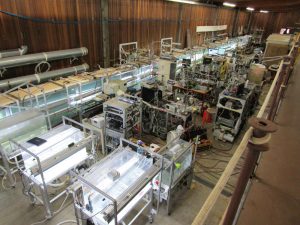Center for Aerosol Impacts on Climate and the Environment

We are part of Center for Aerosol Impacts on Climate and the Environment (CAICE), an NSF Center for Chemical Innovation.
Sea Spray as a source of Atmospheric Particles
The ocean is a major source of natural aerosol particles. When waves break, the bursting of bubbles leads to ejection of particles into the atmosphere. While inorganic salts make up a substantial fraction of the particulate mass, the myriad organic compounds present at the ocean surface are also emitted as particles. These organic compounds make up a major part of the smallest particles emitted, and have a controlling influence on the atmospheric properties and impacts of these particles. Through CAICE, we are working to understand the properties of these organic compounds and their impacts on the atmosphere.
Impacts of Surfactants on Sea Spray Particles and Clouds
Many of the organic compounds produced in the ocean through biochemical cycles and chemical processing are surfactants, meaning that they preferentially partition to the water surface. These surfactant molecules can lead to depression of the surface tension of droplets and can impact the growth of particles into cloud drops. We are using unique tools to investigate how chemical complexity influences the ability of ocean-derived organic molecules to alter the cloud forming abilities of sea spray particles, and to probe differences in surfactant behavior in microscopic droplets compared to macroscopic bulk solutions.
Characterizing the Influence of Ocean-Derived Organic Molecules on Light Scattering by Sea Spray Particles
Particles scatter sunlight. Scattering by particles has an important cooling influence on global climate. The ability of particles to scatter light is strongly linked to their size and composition. In the atmosphere, variations in relative humidity can lead to substantial changes in the water content of particles, and consequently their size. The composition of sea spray particles emitted from wave breaking is linked to the surface composition of the ocean, which is in turn influenced by biochemical cycles in the ocean. We use the unique waveflume located at the Scripps Institution of Oceanography, as well as realistic sea spray particle generation methods developed in CAICE, to probe connections between chemical changes in the ocean and particle properties. Through these studies, we are learning about the coupling between chemical variability in the ocean and the ability of emitted sea spray particles to scatter sunlight. This work provides insights into the behavior of the atmosphere during pre-industrial times, as well as into how future changes in climate and anthropogenic inputs into the ocean might alter the net cooling impact of particles produced from natural sources.
Partner Institutions
- UC San Diego
- University of Wisonsin, Madison
- University of Iowa
- Colorado State University
- Yale University
- Ohio State University
- University of Utah
